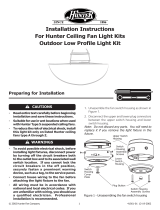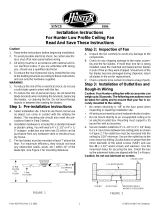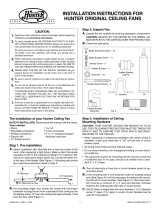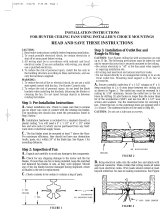
1
41488-01 10/29/2002
®
Installation and Operation Manual
For Hunter Ceiling Fans
41488-01 10/29/2002

2
41488-01 10/29/2002
®

3
41488-01 10/29/2002
®
CONGRATULATIONS!
Your new Hunter ceiling fan is an
addition to your home or office that
will provide comfort and perfor-
mance for many years. This manual
gives you complete instructions for
installing and operating your fan.
We are proud of our work. We ap-
preciate the opportunity to supply
you with the best ceiling fan avail-
able anywhere in the world.
Before installing your fan, record the
following information for your
records and warranty assistance.
Please refer to the carton and the
Hunter nameplate (located on top
outside fan motor housing) for the
proper information.
© 2002 Hunter Fan Co.
10/29/2002
Model Name __________________
Catalog No. ___________________
Serial No. _____________________
Date Purchased ________________
Where Purchased ______________
_____________________________
Attach Your Receipt
or a Copy of
Your Receipt Here

4
41488-01 10/29/2002
®
CONTENTS
Important Information.....................................................................................................................................5
Step 1 - Getting Ready .....................................................................................................................................6
Step 2 - Installing the Ceiling Plate .................................................................................................................8
Step 3 - Assembling the Fan........................................................................................................................... 11
Step 4 - Wiring the Fan .................................................................................................................................. 14
Step 5 - Installing the Canopy........................................................................................................................ 17
Step 6 - Assembling Fan Blades...................................................................................................................... 18
Step 7 - Bulb and Globe Installation.............................................................................................................. 19
Operating Your Hunter Fan ........................................................................................................................... 20
Cleaning and Maintenance ............................................................................................................................ 21
Troubleshooting ............................................................................................................................................. 22

5
41488-01 10/29/2002
®
IMPORTANT INFORMATION
not lock the circuit break-
ers in the off position, se-
curely fasten a prominent
warning device, such as a
tag, to the service panel.
• All wiring must be in accor-
dance with national and lo-
cal electrical codes. If you
are unfamiliar with wiring,
you should use a qualified
electrician.
• To reduce the risk of per-
sonal injury, do not bend
the blade attachment sys-
tem when installing, bal-
ancing, or cleaning the fan.
Never insert foreign objects
between rotating fan
blades.
• The fan blades cannot be
placed lower than 2,3m
from the floor.
DO YOU NEED HELP?
To install a ceiling fan, be sure you
can do the following:
• Locate ceiling joist or other
suitable support in ceiling.
• Drill holes for and install wood
screws.
• Identify and connect electrical
wires.
• Lift 16 kg.
If you need help installing the fan,
your Hunter fan dealer can direct you
to a licensed installer or electrician.
• The installation site must
have an all-pole switch with
a minimum separation gap
of 3 mm.
WARNINGS
• To avoid possible electrical
shock, before installing
your fan, disconnect the
power by turning off the
circuit breakers to the out-
let box and associated wall
switch location. If you can-
CAUTIONS
• Read entire booklet care-
fully before beginning in-
stallation and save these
instructions.
• To reduce the risk of per-
sonal injury, attach the fan
directly to the support
structure of the building ac-
cording to these instruc-
tions, and use only the
hardware supplied.

6
41488-01 10/29/2002
®
GATHERING THE TOOLS
You need the following tools to in-
stall the fan:
• Electric drill with 9/64" bit and
masonry bit
• Standard screwdriver
• Phillips-head screwdriver
• Wrench or pliers
• Two M5 x 30 mm expansion an-
chors (for concrete ceilings only)
OPTIONAL ACCESSORIES
Consider using Hunter’s optional ac-
cessories, such as a wall-mounted or
remote speed control. Follow the in-
structions for installation and use in-
cluded with each Hunter accessory.
For quiet and optimum performance
of your Hunter fan, use only Hunter
speed controls.
STEP 1 - GETTING READY
PREPARING THE FAN SITE
Reliable operation, efficiency, and
maximum energy savings depend
upon proper placement and attach-
ment of the fan. For this reason, we
have included a separate booklet —
“Guide to Choosing and Preparing
a Ceiling Fan Site” — to help you
select the best location for your fan.
The booklet also provides informa-
tion to ensure your fan support and
electric outlet box meet UL-approved
safety codes for ceiling fans.
The instructions in this installation
manual assume that you have used
the “Guide to Choosing and Prepar-
ing a Ceiling Fan Site” to pick the
fan location and make certain the
proper fan support and outlet box
are installed.
CHECKING YOUR FAN PARTS
Carefully unpack your fan parts to
avoid damage. Check for shipping
damage. If one of the fan blades is
damaged, return all blades for re-
placement.
Hint: If installing more than one fan,
keep the fan blades in sets, as
shipped.

7
41488-01 10/29/2002
®
Flush Mounting (Figure 1a) fits close
to the ceiling, for low ceilings less
than 2,6 m high.
Figure 1c - Angle Mounting
Figure 1b - Standard Mounting
Figure 1a - Flush Mounting
25,5 cm
30,5 cm
34
12
8
Standard Mounting (Figure 1b)
hangs from the ceiling by a connec-
tor pipe (included), for ceilings 2,6 m
or higher. For ceilings higher than 2,6
m, you can also purchase Hunter ex-
tension rods. All Hunter fans use
sturdy 2 cm inner diameter pipe to
assure stability and wobble-free per-
formance.
Angle Mounting (Figure 1c) hangs
from a vaulted or angled ceiling.

8
41488-01 10/29/2002
®
STEP 2 - INSTALLING THE CEILING PLATE
1. Drill two pilot holes into the
wood support structure through
the outermost holes on the out-
let box. The pilot holes should be
9/64" in diameter and 4 1/4"
(110mm) apart. See Figure 2a.
2. Insert the 3 rubber isolators into
the 3 round holes in the ceiling
plate as shown in Figure 2b.
Thread the lead wires from the
outlet box through the opening
in the middle of the ceiling plate.
3. Align two opposing oval slots in
the ceiling plate with the pilot
holes in the wood support struc-
ture. See Figure 2b.
ANGLE MOUNTING
For Angle Mounting be sure to orient
the Ceiling Plate so that the arrows
marked on the plate are pointing to-
wards the ceiling peak. See Figure 2b.
Figure 2a - Pilot Holes and Outlet Box
location
40mm x 80mm
Brace
Outlet Box
Lead Wires
Pilot Holes
4. Place a flat washer on each of the
two 3" wood screws and pass the
screws through two opposing
oval slots in the ceiling plate, as
shown in Figure 2c. You may sub-
stitute the 3" wood screws with
the provided 1 1/2" wood screws
for shorter depth installations.
Be sure that enough of the screws
enters the mounting surface to
support the assembled fan.
WARNING
• To avoid possible electrical
shock, before wiring fan,
disconnect power by turn-
ing off the circuit breakers
both to the outlet box and
to its associated wall switch
location. If you cannot lock
the circuit breakers in the
off position, securely fasten
a prominent warning de-
vice, such as a tag, to the
service panel.
• All wiring must be in accor-
dance with national and
local electrical codes. If you
are unfamiliar with wiring,
you should use a qualified
electrician.

9
41488-01 10/29/2002
®
Figure 2c - Attaching Ceiling Plate to
40 mm x 80 mm Brace
Rubber
Isolators (3)
Outlet
Box
Ceiling
Plate
Flat Washer
3" Wood
Screw (2)
40mm x 80mm
Brace
Note: You must purchase the ex-
pansion anchors separately. Drill
the holes in the ceiling to the
depth and diameter recom-
mended by the manufacturer of
the expansion anchors.
2. Drill two holes 110 mm (4,32")
apart on either side of the mains
as shown in Figure 2d. The holes
are for M5 x 30 mm expansion
anchors.
3. Drive the expansion anchors into
the holes until the ends of the an-
chors are flush with the ceiling.
See Figure 2e.
5. Tighten the screws into the 9/64"
pilot holes.
Note: The rubber isolators in the
ceiling plate should be compressed
against the ceiling. Do not over-
tighten.
FOR CONCRETE CEILINGS
1. Locate the electrical supply mains
in the ceiling.
110 mm
Electrical Mains
Ceiling
Masonry Bit
Figure 2d - Drilling Anchor Holes
4. Hold the Ceiling Plate up to the
ceiling and align two opposing
oval slots in the Ceiling Plate with
the expansion anchors. See Fig-
ure 2b. Be sure that the electri-
cal mains protrude through the
center opening in the Ceiling
Plate by at least 150 mm.
continued
Figure 2b - Correct Position of Ceiling
Plate for Angle Mounting and location
of rubber isolators.
Rubber
Isolators (3)
Arrows
toward
ceiling
peak
Oval slots for
attaching ceiling
plate to ceiling

10
41488-01 10/29/2002
®
Figure 2f - Attaching Ceiling Plate to
Ceiling
M5 x 30 mm Screw (2)
(supplied with anchor)
Ceiling
Plate
Rubber
Isolators
(3)
5. Drive the M5 x 30 mm screws
into the anchors so that the Ceil-
ing Plate is tight against the ceil-
ing. See Figure 2f.
Note: The rubber isolators in the
Ceiling Plate should be com-
pressed against the ceiling. Do not
overtighten.
Figure 2e - Driving Expansion Anchors
into Holes
Expansion
Anchor
Flush With
Ceiling

11
41488-01 10/29/2002
®
STEP 3 - ASSEMBLING THE FAN
continued
1. Remove the Pipe Setscrew. Note:
Save the Pipe Setscrew for pos-
sible future use in Standard or
Angle Mounting. With the fan as-
sembly resting level in the pack-
ing foam, first feed the wiring har-
ness thorough the center of the
upper canopy, followed by the
lower canopy, then through the
hanger bracket, and lastly through
the low profile adapter. See
figure 3a.
2. Fit the low profile adapter down
inside the hanger bracket, align-
ing the flat section on the low pro-
file adapter with the flat section
in the hanger bracket. To clear
the two screws that project into
the hanger bracket, you may need
to tip the flat section of the low
profile adapter down slightly,
while inserting it into the hanger
bracket. See figure 3b.
WARNING
• To reduce the risk of fire,
electrical shock, or motor
damage, do not lift or carry
the fan by the lead wires.
• To prevent damage to the
wires on the bottom of the
fan assembly, do not sit fan
on hard surface. Use foam
inside box as support.
• The pipe adapter has a spe-
cial coating on the threads.
Do not remove this coating;
the coating prevents the
pipe from unscrewing.
Once assembled, do not re-
move the pipe.
LOW PROFILE MOUNTING
Refer to Figures 3a, 3b and 3c for the
following steps.
Figure 3a - Installing Low Profile
Adapter
Low Profile
Adapter
Hanger
Bracket
Lower
Canopy
Upper
Canopy
Fan
Pipe
Setscrew
Plug

12
41488-01 10/29/2002
®
3. Align the three slots in the low
profile adapter with the three
screw holes in the fan assembly
as shown in Figure 3c. Thread one
of the #8-32 x 3/4" SEMS screws
into the threaded hole in the fan
assembly and the hanger bracket.
Tighten all three screws securely.
After the three screws are tight-
ened, the lower canopy should be
free to rotate.
4. Proceed to STEP 4 - WIRING THE FAN.
Figure 3b - inserting the low profile
adapter
assembly and partially tighten it.
Repeat for the other two screws.
Once all three #8-32 x 3/4" SEMS
screws are partially threaded into
the fan assembly, center the lower
canopy with the hanger bracket,
making sure that the lower canopy
is not captured between the fan
• one positioning screw located on
the Trilobular
TM
ball assembly, and
• one locking pin.
1. With the fan assembly resting in
the packing foam, feed the wir-
ing harness from the fan through
the pipe.
2. Screw pipe into fan assembly until
tight.
IMPORTANT! Fully tighten pipe
setscrew as indicated in Figure 3d.
3. Thread the wiring harness first
through the upper canopy, the
lower canopy, and then the
hanger bracket, resting them on
the motor housing.
4. Thread the wiring harness through
the Trilobular
TM
ball and slide the
ball onto the pipe, resting it on
the fan assembly.
5. Thread the wiring harness through
the wedge and slide the wedge
onto the top part of the pipe.
Align the openings in the wedge
STANDARD MOUNTING
AND ANGLE MOUNTING
Included with the fan are:
• one 89 mm (3 1/2") long pipe,
• one wedge
Low Profile
Adapter
Hanger
Bracket
Figure 3c - Attaching the low profile
adapter.
Low Profile Adapter
Hanger Bracket

13
41488-01 10/29/2002
®
with the matching holes on the
pipe as shown in Figure 3e. Insert
the pin into the two holes in the
pipe so that the pin is centered
evenly in the hole, see Figure 3e.
6. Align the cutouts in the Trilobular
TM
ball with the pin.
7. Slide the Trilobular
TM
ball up the
pipe until it hits the pin.
8. Insert and tighten the positioning
screw into the Trilobular
TM
ball. See
Figure 3f.
Figure 3e - Pipe & Trilobular
TM
Ball
assembly components
Pin
Positioning Screw
Trilobular
TM
Ball
3 1/2" Pipe
Wedge
Figure 3f - Pipe, Wedge, Pin &
Trilobular
TM
Ball assembly.
WARNING
• Failure to complete the
steps above properly could
result in the fan falling.
Figure 3d - Inserting Pipe through
Canopy and Trilobular
TM
Ball
Pipe
Upper
Canopy
Plug
Pipe Setscrew
Trilobular
TM
Ball
Positioning
Screw
Pin
Wedge
Lower Canopy
Fan
Hanger
Bracket

14
41488-01 10/29/2002
®
STEP 4 - WIRING THE FAN
WARNING
• To avoid possible electrical
shock, before wiring fan,
disconnect power by turn-
ing off the circuit breakers
both to the outlet box and
to its associated wall switch
location. If you cannot lock
the circuit breakers in the
off position, securely fasten
a prominent warning de-
vice, such as a tag, to the
service panel.
• All wiring must be in accor-
dance with national and
local electrical codes. If you
are unfamiliar with wiring,
you should use a qualified
electrician.
• Failure to complete the sub
steps 1-3 below could result
in the fan falling.
WARNING
To reduce the risk of fire, elec-
trical shock, or motor damage,
do not lift or carry the fan by
the lead wires.
1. Disconnect the power by turning
off the circuit breakers to the out-
let box and associated wall switch
location.
2. Carefully lift the fan assembly and
position the hanger bracket with
the ceiling plate as shown in Fig-
ure 4a.
3. Rotate the hanger bracket until
the three tabs on the hanger
bracket are fully engaged in the
three slots in the ceiling plate.
See Figure 4b. Being careful to
not allow the hanger bracket to
rotate, temporarly install one of
Figure 4a - Aligning the Hanger
Bracket with the Ceiling Plate
Hanger
Bracket
Ceiling Plate
#6-32 x
3/8"
Figure 4b - Temporary installation of
one #6-32 x 3/8" screw.
Ceiling Plate
Hanger
Bracket
Tab (3)
Slot in Ceiling
Plate (3)

15
41488-01 10/29/2002
®
CAUTION
Be sure no bare wire or wire
strands are visible after making
connections.
continued
the three #6-32 x 3/8" screws
through the hole in the ceiling
plate and into the threaded hole
in the hanger bracket to prevent
the hanger bracket from rotat-
ing. See figure 4b.
CONNECTING FAN TO
ELECTRICAL SOURCE
Use Figures 4c, 4d and 4e for refer-
ence in making the following elec-
trical connections.
1. Connect the supply mains to the
terminal block mounted on the
hanger bracket.
2. Connect the safety earth (green/
yellow) wire to the terminal
marked .
3. Connect the blue neutral wire to
the terminal marked “N.”
4. Connect the brown line wire to
the terminal marked “L.”
Note: An additional “L” termi-
nal is provided for separate con-
trol of the light kit, if a separate
supply line is provided for that
purpose.
5. Connect the motor leads to the
harness assembly attached to the
hanger bracket and terminal
block. See Figure 4c, 4d and 4e.
Note: Unless there is a separate
line for the light kit, connect the
black/white wire and the brown
wire from the motor housing to
the same “L” terminal.

16
41488-01 10/29/2002
®
Hanger Bracket
Connect Plugs
Fan
Power
Wires
In
Ceiling
Outlet Box
40 mm x 80 mm
Brace
Earth
Blue
Brown
(Optional Line)
Wall Switch Wire For
Separate Control of Light Kit
(Note: Wall switch
must be acceptable
as a general-use
switch.)
Figure 4e - Hanger Bracket &
Terminal Connections
EARTH
GRN/YEL
GRN/YEL
MOTO
R
LEAD
S
S
UPPLY
MAINS
BLUE
BROWN
BLK/WHT
NEUTRAL
LINE
OPTIONAL
NLL
Figure 4c - Wiring Diagram
Figure 4d - Terminal Block
Connections

17
41488-01 10/29/2002
®
STEP 5 - INSTALLING THE CANOPY
2. Raise the lower canopy up over
the hanger bracket and align the
three holes in the lower canopy
with the three holes in the ceil-
ing plate and the three threaded
screw holes on the hanger
bracket as shown in Figure 5a.
You may need to slightly spread
the tabs apart on the lower
canopy to align them with the
holes on the ceiling plate and
hanger bracket.
3. Install and securely tighten the
three #6-32 x 3/8" screws.
4. Raise the upper canopy and align
the three screw holes in the up-
per canopy with the three
threaded holes in the ceiling
plate. Install and tighten the three
#6-32 x 1/4" screws as shown
in Figure 5b.
WARNING
• When removing the #6-32
x 3/8" screw that was tem-
porarily installed in STEP 4
- WIRING THE FAN, do not
allow the hanger bracket to
rotate in the ceiling plate
as this could cause the fan
to fall.
• Failure to complete sub-
steps 1 through 3 could
cause fan to fall.
1. Being careful to not allow the
hanger bracket to rotate in the
ceiling plate, remove the single
#6-32 x 3/8" screw that was in-
stalled in STEP 4 - WIRING THE
FAN, sub step 3.
Figure 5a - Attaching Lower Canopy
and Hanger Bracket to Ceiling Plate
#6-32 x 3/8"
screws (3)
Lower Canopy
Ceiling Plate
Hanger
Bracket
Figure 5b - Attaching Upper Canopy
#6-32 x 1/4"
screws (3)
Lower Canopy
Upper Canopy

18
41488-01 10/29/2002
®
Figure 6a Figure 6b
1. Attach each blade to the blade
bracket using three blade assem-
bly screws as shown in Figure 6a.
Insert the assembly screws into
the blade bracket, through the
blade and into the medallion, with
the blade sandwiched between
the blade bracket and medallion as
shown in Figure 6a.
2. Working through the large clear-
ance holes in the light/switch hous-
STEP 6 - ASSEMBLING FAN BLADES
ing, remove the 2 screws from the
motor hub as shown in Figure 6a
and 6b. Position the blade bracket
to align with the holes on the
motor hub and insert a mounting
screw (provided) in one of the
holes in the blade bracket. Use a
screwdriver to hold in place. Align
Blade Bracket
Blade
Medallion
Blade
Mounting
Screws
blade holes with mounting holes
in the motor hub by turning screw
and readjusting blade bracket un-
til screw mates with threaded hole
in motor hub. Do not tighten
screws until both screws have
been partially installed into the
motor hub through the blade
bracket. Repeat for all blades, ro-
tating motor hub as needed to
expose mounting holes. See Fig-
ures 6a, 6b and 7a.
A blade balancing kit has been pro-
vided with your fan. Should the fan
wobble in operation, you may use this
kit to correct the balance per the in-
structions supplied with the kit.
Blade Mounting
Screws
Clearance
Hole

19
41488-01 10/29/2002
®
STEP 7 - BULB AND GLOBE INSTALLATION
Figure 7a
CAUTION
To prevent damage to light fix-
ture, do not sit fan on hard sur-
face. Use foam inside box as
support.
1. Install (2) 60W light bulbs (not in-
cluded). Position the indentations
in the outer rim of the glass shade
so that they line up with the tabs
on the inside surface of the fan
light fixture rim. See Figure 7a.
2. Carefully lift the glass shade up
inside the light fixture as far as it
will go. Rotate the shade in a
clockwise direction until it is held
tightly in place by the three tabs.
Indentations
Tabs
Glass Shade
Reversing
Switch
Motor
Blade and
Bracket
Switch Housing

20
41488-01 10/29/2002
®
OPERATING YOUR HUNTER FAN
blades, possibly resulting in
damage to blades or pull cord.
3. Ceiling fans work best by blow-
ing air downward (counter-
clockwise blade rotation) in
warm weather to cool the
room with a direct breeze. In
winter, having the fan draw air
upward (clockwise blade rota-
tion) will distribute the warmer
air trapped at the ceiling around
the room without causing a
draft. Refer to Figure 8b.
To change the direction of air flow,
turn the fan off and let it come to
a complete stop. Push the revers-
ing switch on the fan as shown in
Figure 8c. Restart fan.
4. If your fan wobbles when operat-
ing, use the enclosed balancing kit
and the accompanying instructions
to balance the fan.
Figure 8b - Air Flow Patterns
Figure 8c - Pull Chain and Reversing
Switch
1. Turn electrical service “on” at main
panel.
2. The Fan Pull Cord controls power
to the fan. It has four settings in
sequence: High, Medium, Low
and Off.
• Pull the cord slowly to change
settings.
• Release slowly to prevent the
cord from recoiling into the
Control switches are identified by the
following symbols as shown in Figure
8a.
Fan Light Reversing
Figure 8a - Control Switch Symbols
Pull
Chain
Reversing
Switch
Page is loading ...
Page is loading ...
Page is loading ...
-
 1
1
-
 2
2
-
 3
3
-
 4
4
-
 5
5
-
 6
6
-
 7
7
-
 8
8
-
 9
9
-
 10
10
-
 11
11
-
 12
12
-
 13
13
-
 14
14
-
 15
15
-
 16
16
-
 17
17
-
 18
18
-
 19
19
-
 20
20
-
 21
21
-
 22
22
-
 23
23
Hunter Fan 24533 Owner's manual
- Category
- Household fans
- Type
- Owner's manual
Ask a question and I''ll find the answer in the document
Finding information in a document is now easier with AI
Related papers
-
 Hunter Fan 28388 Owner's manual
Hunter Fan 28388 Owner's manual
-
 Hunter Fan 22890 Owner's manual
Hunter Fan 22890 Owner's manual
-
Hunter Fan TYPE 2 Owner's manual
-
Hunter Fan 23850 Owner's manual
-
Hunter Fan 23850 Owner's manual
-
 Hunter Fan 25574 Owner's manual
Hunter Fan 25574 Owner's manual
-
Hunter Fan 23827 User manual
-
 Hunter Fan 21296 Owner's manual
Hunter Fan 21296 Owner's manual
-
 Hunter Fan 24711 Owner's manual
Hunter Fan 24711 Owner's manual
-
 Hunter Fan 21926 Owner's manual
Hunter Fan 21926 Owner's manual





























